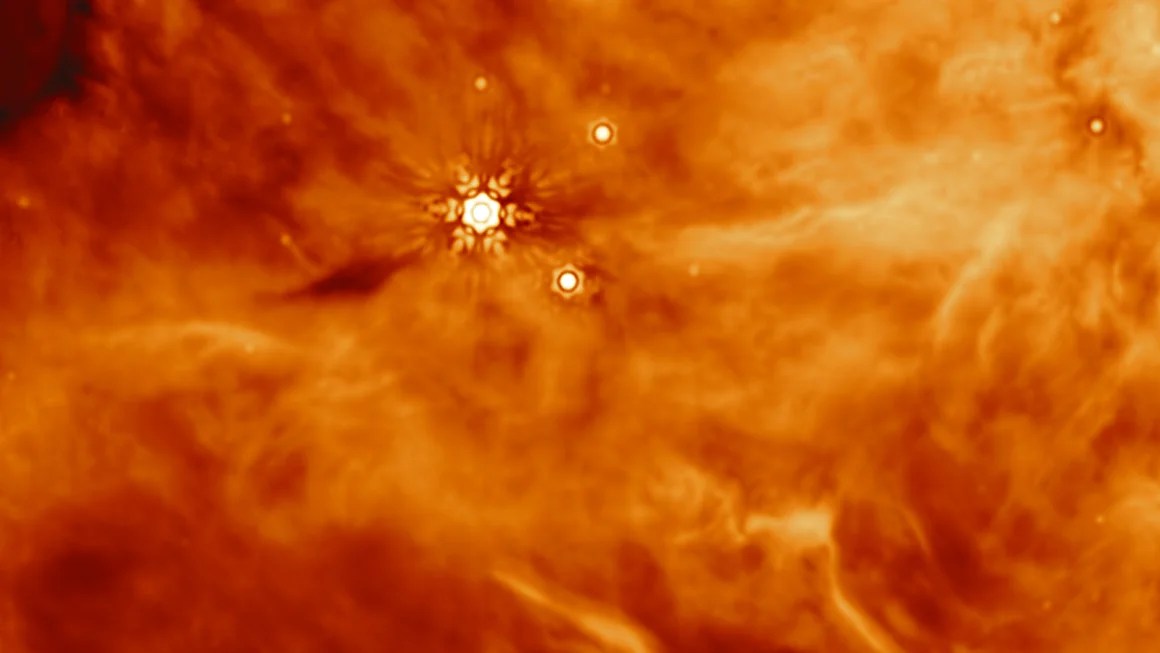(CNN) — Astronomers using the James Webb Space Telescope have detected common chemicals found in vinegar, ant stings and daisies surrounding two young stars, NASA said.
Among the complex organic molecules they observed using the space observatory's mid-infrared instrument were acetic acid, a component of vinegar, and ethanol, also known as alcohol.
The team also detected single molecules of formic acid, which causes the burning sensation associated with ant bites, as well as sulfur dioxide, methane and formaldehyde. Scientists theorize that sulfur compounds like sulfur dioxide may have played an important role in the early Earth, which eventually paved the way for life.
The newly discovered molecules were observed as icy compounds around IRAS 2A and IRAS 23385, two protostars, or young stars that have not yet formed planets. The Stars form from swirling clouds of gas and dustAnd the material left over from star formation forms the planets.
According to previous research, the protostar IRAS 23385 is estimated to be 15,981 light-years away in the Milky Way from Earth.
The new observation intrigues astronomers because the molecules detected around stars could be important materials for habitable worlds, and those materials could be incorporated into planets that could eventually form around stars.
Space is full of heavy metals and chemical elements and compounds that are created and released by stellar explosions over time. In turn, the chemical elements combine in the clouds to form the next generation of stars.
On Earth, the right combination of elements allowed life to form, and as famous astronomer Carl Sagan once said, “We're made of star stuff.” But astronomers have long questioned how common the elements necessary for life are across the universe.
A search for complex molecules in space
Previously, scientists using the Web discovered ice types made of various elements in a cold, dark molecular cloud, a galaxy of gas and dust where hydrogen and carbon monoxide molecules can form. Dense clusters can collapse into these clouds to form protostars.
Detecting complex organic molecules in space helps astronomers determine the origin of molecules and other large cosmic molecules.
Scientists believe that complex organic molecules are formed through the sublimation of ice in space, or when a solid first turns into a gas rather than a liquid, and Webb's new detection provides evidence for that theory.
“This discovery contributes to one of the long-standing questions in astrophysics,” said Will Rocha, team leader of the James Webb Young Protostar Observatory and postdoctoral researcher at Leiden University in the Netherlands. “What is the origin of complex organic molecules, or COM, in space? Are they formed in the gas phase or in ice? The detection of COM in ice grains suggests that solid-phase chemical reactions on the grain surface of cold dust can form the complex. Types of molecules.
A study describing the new discovery of protostars has been accepted for publication in the journal Astronomy & Astrophysics.
A look at the early solar system
Understanding the shape that complex organic molecules take can help astronomers better understand the ways in which molecules join together in planets. Complex organic molecules trapped in cold ice eventually become part of comets or asteroids, which collide with planets and essentially provide life-sustaining material.
Chemicals found around protostars may reflect the early history of our solar system, allowing astronomers to observe what the Sun and the planets around it, including the Earth, were like when they formed.
“All of these molecules become part of comets and asteroids and eventually form new planetary systems, when the icy material forms a protostellar system in the planet-forming disk,” said Professor of Molecular Astrophysics at Leiden, Evin van Dishoek. The university said in a statement. “We hope to gradually follow this astrochemical path with additional data from the Web in the coming years.”
The team dedicated the results of its research to study co-author Harold Linnards, who died unexpectedly in December, before the paper was accepted for publication.
Linnards, who led the Leiden Astrophysical Laboratory and coordinated the measurements used in the study, was a “world leader in laboratory studies of gas and ice molecules in interstellar space,” according to a statement from Leiden University.
Webb is said to be excited by the data he captured and what the findings mean for astrochemical research.
“Harold was very excited that lab work could play an important role in the COM work, because it's been a long road to get here,” said van Dishoek.





:quality(85)/cloudfront-us-east-1.images.arcpublishing.com/infobae/KTKFKR763RBZ5BDQZJ36S5QUHM.jpg)